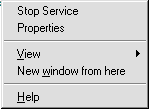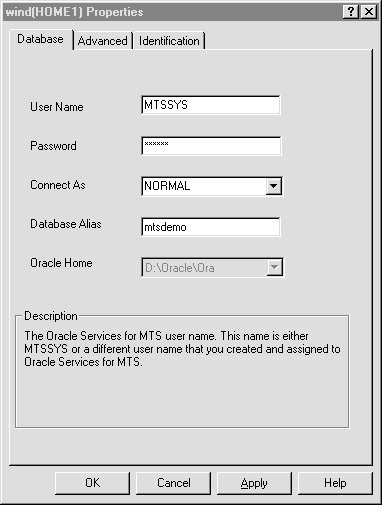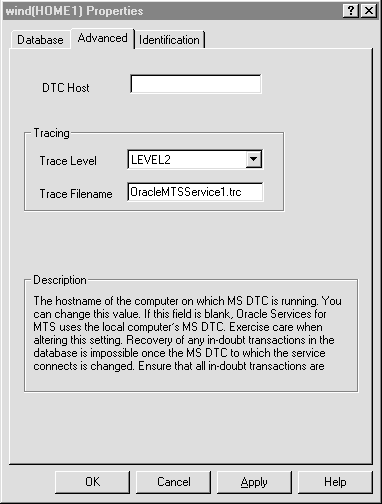Release 8.1.6 for Windows NT
Part Number A73029-01
Library |
Product |
Contents |
Index |
| Using Microsoft Transaction Server with Oracle8 Release 8.1.6 for Windows NT Part Number A73029-01 |
|
This appendix describes how to delete or modify an existing Oracle Service for MTS.
Specific topics discussed are:
You cannot modify an existing Oracle Service for MTS to connect to a different Oracle8 database. The Oracle8 database for which the Oracle Service for MTS was originally created must always remain the same. Instead, delete the existing Oracle Service for MTS and create a new one for the second Oracle8 database. If necessary, however, you can modify the database alias, Oracle home, user name, and password of an existing Oracle Service for MTS as long as the Oracle8 database remains the same. The table below describes the procedures to follow for deleting or modifying an existing Oracle Service for MTS:
| On The... | What Procedures Must You Perform if You Want to... | |
|---|---|---|
| Delete the Oracle Service for MTS? | Modify the Oracle Service for MTS? | |
|
Client computer |
None. |
None. |
|
Windows NT computer where Microsoft Transaction Server is installed |
To delete an existing Oracle Service for MTS, see sections:
If Oracle Service for MTS deletion is unsuccessful, see section: |
To modify an existing Oracle Service for MTS, see sections: Then see the appropriate section:
If Oracle Service for MTS modification is unsuccessful, see section: |
|
Computer where the Oracle8 database is installed |
None. |
None. |
Modifying a currently operating Oracle Service for MTS to connect to a different MS DTC; modifying the net service name, Oracle home name, user name, or password; or deleting an Oracle Service for MTS may require the DBA to manually commit or abort transactions that did not successfully complete and/or recover.
For this reason, you must prepare the Oracle Service for MTS before it can be deleted or modified to access a different MS DTC or use different connection information. Follow these procedures to ensure that:
To prepare to modify or delete an existing Oracle Service for MTS:
The Microsoft Management Console appears.
A menu appears with several options.
A message indicates that the Oracle Service for MTS has stopped.
C:\> SQLPLUS
ENTER USER-NAME: INTERNAL
SQL> SHUTDOWN
SQL> STARTUP
SQL> EXIT
The Microsoft Management Console appears.
A menu appears with several options.
A message indicates that the Oracle Service for MTS has started.
A message indicates that the Oracle Service for MTS has stopped.
C:\> SQLPLUS
ENTER USER-NAME: INTERNAL
SQL> DELETE FROM MTS_PROXY_INFO; SQL> COMMIT;
This section describes how to delete an existing Oracle Service for MTS. You must use the Microsoft Management Console Explorer to delete the Oracle Service for MTS. Deleting the Oracle Service for MTS in any other way (such as with your keyboard's Delete button) can cause data inconsistencies in the Oracle8 database. These inconsistencies require the DBA to manually commit or abort transactions that did not successfully complete and/or recover.
To delete an existing Oracle Service for MTS:
The Microsoft Management Console appears.
A menu appears with several options.

A message indicates that the Oracle Service for MTS has stopped.
A menu appears with several options.
If successful, a message indicates that the Oracle Service for MTS has been deleted.
If unsuccessful, a message indicates that the Oracle Service for MTS has not been deleted. See section "Manually Deleting or Modifying the Oracle Service for MTS with the Registry". After completing those procedures, retry steps 8 and 9 above.
The Oracle Service for MTS includes a Database tab in the Properties dialog box that enables you to modify the net service name, Oracle home, user name, and password of an existing Oracle Service for MTS.
To modify Oracle Service for MTS connection information:
The Microsoft Management Console appears.
A menu appears with several options.

A message indicates that the Oracle Service for MTS has stopped.
A menu appears with several options.
The Properties dialog box appears.
The Database tab of the Properties dialog box displays information similar to the following:

The user name, password, database alias, and Oracle home that you specify must still connect to the same Oracle8 database for which the Oracle Service for MTS was originally created.
Attention:
If successful, the Oracle Service for MTS can now connect to the Oracle8 database with the information specified in step 10.
If not successful, the Oracle Service for MTS is unable to connect to the Oracle8 database with the information specified in step 10. See section "Manually Deleting or Modifying the Oracle Service for MTS with the Registry". After completing those procedures, retry steps 7 through 11 above.
The Oracle Service for MTS includes an Advanced tab in the Properties dialog box that enables you to modify the following information:
To modify trace file and MS DTC information:
The Microsoft Management Console appears.
A menu appears with several options.

The Properties dialog box appears.
The Advanced tab of the Properties dialog box displays the following information:

| Field | Displays the... |
|---|---|
|
DTC Host |
Hostname of the computer on which MS DTC is running. You can change this value. If this field is blank, the Oracle Service for MTS uses the local computer's MS DTC. When changing the hostname, ensure that the service can: The default service account is "LocalSystem", which may not have privileges to log on to the remote host. In such cases, change the logon account of the service (using the Control Panel) to an account that can access the new host. Exercise care when altering this setting. Recovery of any in-doubt transactions in the database is impossible once the MS DTC to which the service connects is changed. Ensure that all in-doubt transactions are resolved before changing the MS DTC to which the service connects. |
|
Trace Level |
Level of detail for trace recording. The range of values are NOTRACE (for no tracing), LEVEL1, LEVEL2, LEVEL3, and LEVEL4 (for highest tracing). The information recorded includes: LEVEL1 only records errors in the trace file. If no errors occur, no information is written to the trace file and Oracle Service for MTS performance is not impacted. LEVEL2 (the default setting) records both errors and minimal transaction information. This means that Oracle Service for MTS performance can be impacted, particularly in a high traffic environment. Test Oracle Service for MTS performance in your Oracle8 database environment to determine the proper trace level. Resetting the trace level to LEVEL1 is typically sufficient for most Oracle8 database environments. Note: The higher you set the trace level, the more Oracle Service for MTS performance is impacted. See section "Using Trace Files" for additional information on trace settings. |
|
Trace Filename |
Trace file name. If a directory path is not provided, the file is created in ORACLE_BASE\ORACLE_HOME\ORAMTS\TRACE. |
Before the Oracle Service for MTS can be deleted or modified to connect to a different Oracle8 database, it must be cleanly disassociated from the Oracle8 database to which it has been connecting. Sometimes this disassociation fails. Follow the instructions in this section only if the following procedures were unsuccessful:
The Microsoft Management Console Explorer can fail to delete or modify the Oracle Service for MTS if any of the following occur:
To manually delete or modify Oracle Service for MTS with the registry:
C:\> REGEDT32
The Registry Editor window appears.
where n is the number of the Oracle Service for MTS.
The right-hand side of the window shows various parameters and values associated with OracleMTSServicen, including the following:
| Parameter | This Parameter Contains the... |
|---|---|
|
ORAMTS_SUNAME |
Oracle Service for MTS user name. |
|
ORAMTS_SUPWD |
Password for the above account (encrypted in the registry). Do not change the password in the registry. You can only change the password from within the Database tab of the Oracle Service for MTS Properties dialog box in the Oracle Manager for MTS Services snap-in. See section "Modifying Oracle Service for MTS Connection Information" for instructions. |
|
ORAMTS_ORADB |
Database alias for connecting with the Oracle Service for MTS to the Oracle8 database. |
C:\> SQLPLUS
ENTER USER-NAME: USERNAME/PASSWORD@NET_SERVICE_NAME
where NET_SERVICE_NAME is the net service name for connecting to the database. The password is stored in the registry in encrypted form. Use plain text passwords when connecting with SQL*Plus.
SQL> SELECT NAME, DBID FROM V$DATABASE;
which displays information similar to the following:
NAME DBID --------------------- ORCL 12345678
SQL> SELECT RMGUID FROM MTS_PROXY_INFO;
which displays information similar to the following:
RMGUID ------------------------- 2320b23e93e09fff02a231974
If not all values match, the Oracle8 database is not the same one to which the Oracle Service for MTS connects. If you continue, Oracle Service for MTS installation on the database breaks. This can leave the database in an inconsistent state that requires DBA intervention to correct. The reason SQL*Plus connected to a different database than the Oracle Service for MTS is mismatching TNSNAMES.ORA files.
SQL> DELETE FROM MTS_PROXY_INFO; SQL> COMMIT;
SQL> EXIT
| If You Were... | Return to... |
|---|---|
|
Deleting Oracle Service for MTS |
Steps 8 and 9 of section "Deleting an Existing Oracle Service for MTS". |
|
Modifying Oracle Service for MTS to access a different Oracle8 database |
Steps 7 through 11 of section "Modifying Oracle Service for MTS Connection Information". |
Ensure that you delete the roles and privileges assigned to an Oracle Service for MTS user that you no longer want to use.
To delete roles and privileges of an Oracle Service for MTS user:
C:\> SQLPLUS
ENTER USER-NAME: INTERNAL
SQL> @ORACLE_BASE\ORACLE_HOME\ORAMTS\ADMIN\REVOKEUSER.SQL;
SQL> EXIT
|
|
 Copyright © 1996-2000, Oracle Corporation. All Rights Reserved. |
|